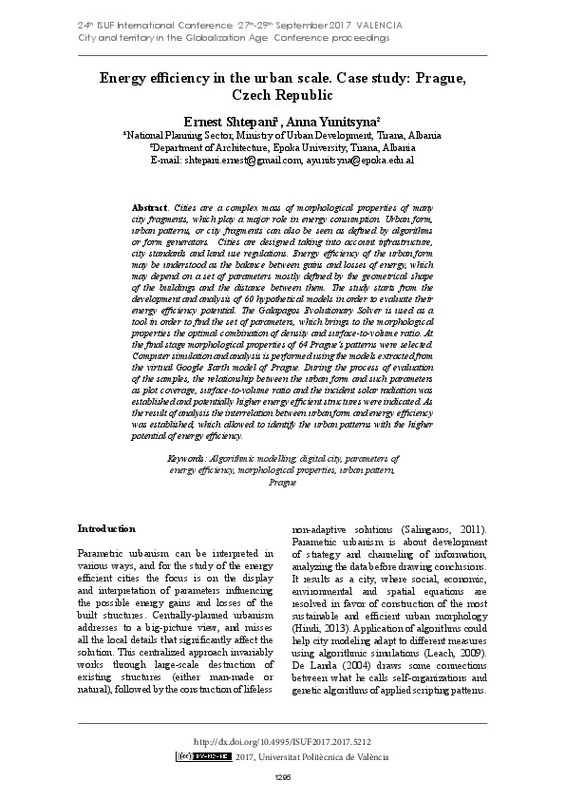JavaScript is disabled for your browser. Some features of this site may not work without it.
Buscar en RiuNet
Listar
Mi cuenta
Estadísticas
Ayuda RiuNet
Admin. UPV
Energy Efficiency in the Urban Scale: Case Study – Prague, Czech Republic
Mostrar el registro sencillo del ítem
Ficheros en el ítem
| dc.contributor.author | Shtepani, Ernest
|
es_ES |
| dc.contributor.author | Yunitsyna, Anna
|
es_ES |
| dc.coverage.spatial | east=14.43780049999998; north=50.0755381; name= Praha, Txèquia | es_ES |
| dc.date.accessioned | 2018-12-21T10:24:00Z | |
| dc.date.available | 2018-12-21T10:24:00Z | |
| dc.date.issued | 2018-04-20 | |
| dc.identifier.isbn | 9788490485743 | |
| dc.identifier.uri | http://hdl.handle.net/10251/114354 | |
| dc.description.abstract | [EN] Cities are a complex mass of morphological properties of many city fragments, which play a major role in energy consumption. Urban form, urban patterns, or city fragments can also be seen as defined by algorithms or form generators. Cities are designed taking into account infrastructure, city standards and land use regulations. Energy efficiency of the urban form may be understood as the balance between gains and losses of energy, which may depend on a set of parameters mostly defined by the geometrical shape of the buildings and the distance between them. The study starts from the development and analysis of 60 hypothetical models in order to evaluate their energy efficiency potential. The Galapagos Evolutionary Solver is used as a tool in order to find the set of parameters, which brings to the morphological properties the optimal combination of density and surface-to-volume ratio. At the final stage morphological properties of 64 Prague’s patterns were selected. Computer simulation and analysis is performed using the models extracted from the virtual Google Earth model of Prague. During the process of evaluation of the samples, the relationship between the urban form and such parameters as plot coverage, surface-to-volume ratio and the incident solar radiation was established and potentially higher energy efficient structures were indicated. As the result of analysis the interrelation between urban form and energy efficiency was established, which allowed to identify the urban patterns with the higher potential of energy efficiency. | es_ES |
| dc.format.extent | 8 | es_ES |
| dc.language | Inglés | es_ES |
| dc.publisher | Editorial Universitat Politècnica de València | es_ES |
| dc.relation.ispartof | 24th ISUF International Conference. Book of Papers | es_ES |
| dc.rights | Reconocimiento - No comercial - Sin obra derivada (by-nc-nd) | es_ES |
| dc.subject | Algorithmic modelling | es_ES |
| dc.subject | Digital city | es_ES |
| dc.subject | Parameters of energy efficiency | es_ES |
| dc.subject | Morphological properties | es_ES |
| dc.subject | Urban pattern | es_ES |
| dc.subject | Prague | es_ES |
| dc.title | Energy Efficiency in the Urban Scale: Case Study – Prague, Czech Republic | es_ES |
| dc.type | Capítulo de libro | es_ES |
| dc.type | Comunicación en congreso | es_ES |
| dc.identifier.doi | 10.4995/ISUF2017.2017.5212 | |
| dc.rights.accessRights | Abierto | es_ES |
| dc.description.bibliographicCitation | Shtepani, E.; Yunitsyna, A. (2018). Energy Efficiency in the Urban Scale: Case Study – Prague, Czech Republic. En 24th ISUF International Conference. Book of Papers. Editorial Universitat Politècnica de València. 1295-1302. https://doi.org/10.4995/ISUF2017.2017.5212 | es_ES |
| dc.description.accrualMethod | OCS | es_ES |
| dc.relation.conferencename | 24th ISUF 2017 - City and Territory in the Globalization Age | es_ES |
| dc.relation.conferencedate | Septiembre 27-29,2017 | es_ES |
| dc.relation.conferenceplace | Valencia, Spain | es_ES |
| dc.relation.publisherversion | http://ocs.editorial.upv.es/index.php/ISUF/ISUF2017/paper/view/5212 | es_ES |
| dc.description.upvformatpinicio | 1295 | es_ES |
| dc.description.upvformatpfin | 1302 | es_ES |
| dc.type.version | info:eu-repo/semantics/publishedVersion | es_ES |
| dc.relation.pasarela | OCS\5212 | es_ES |








